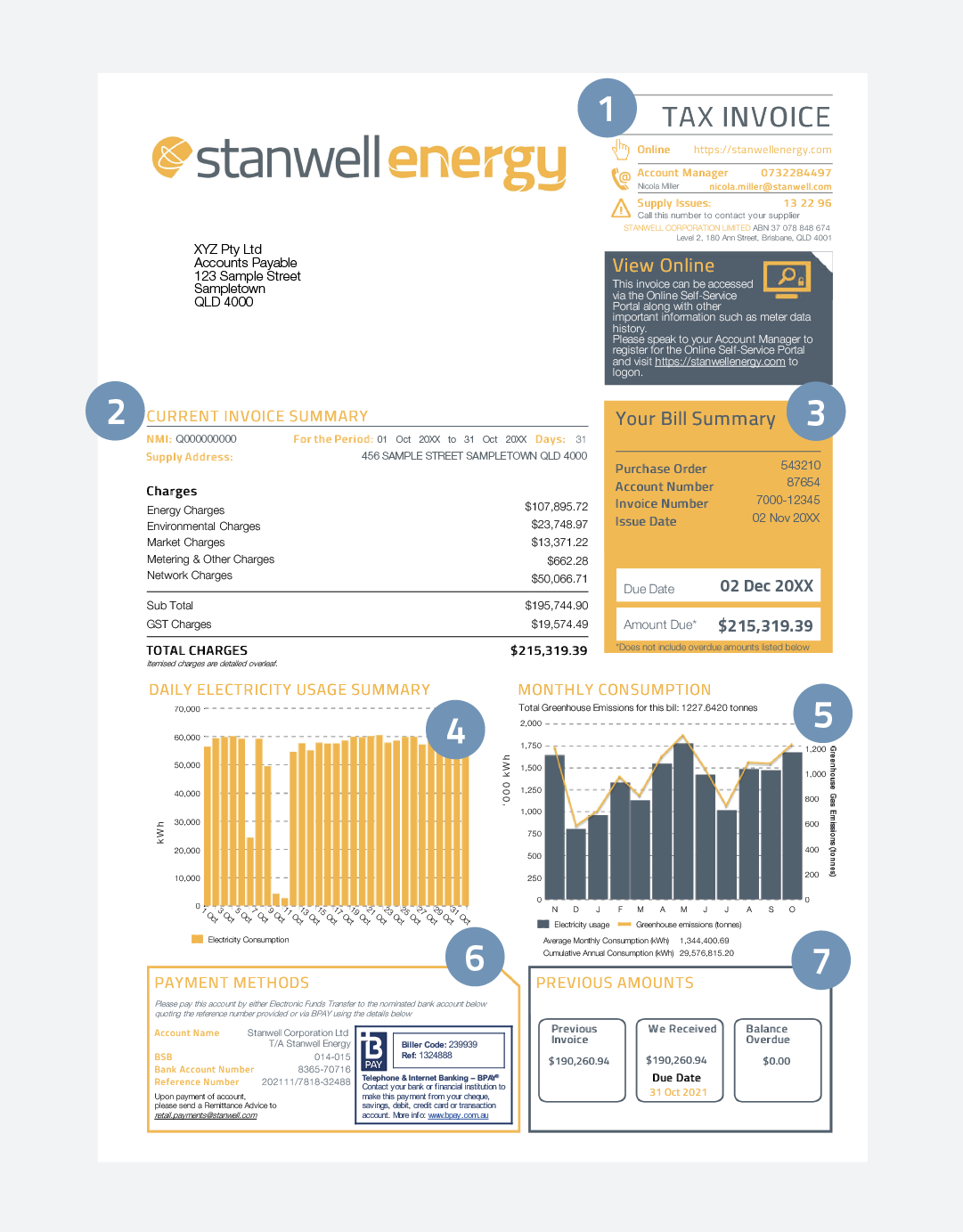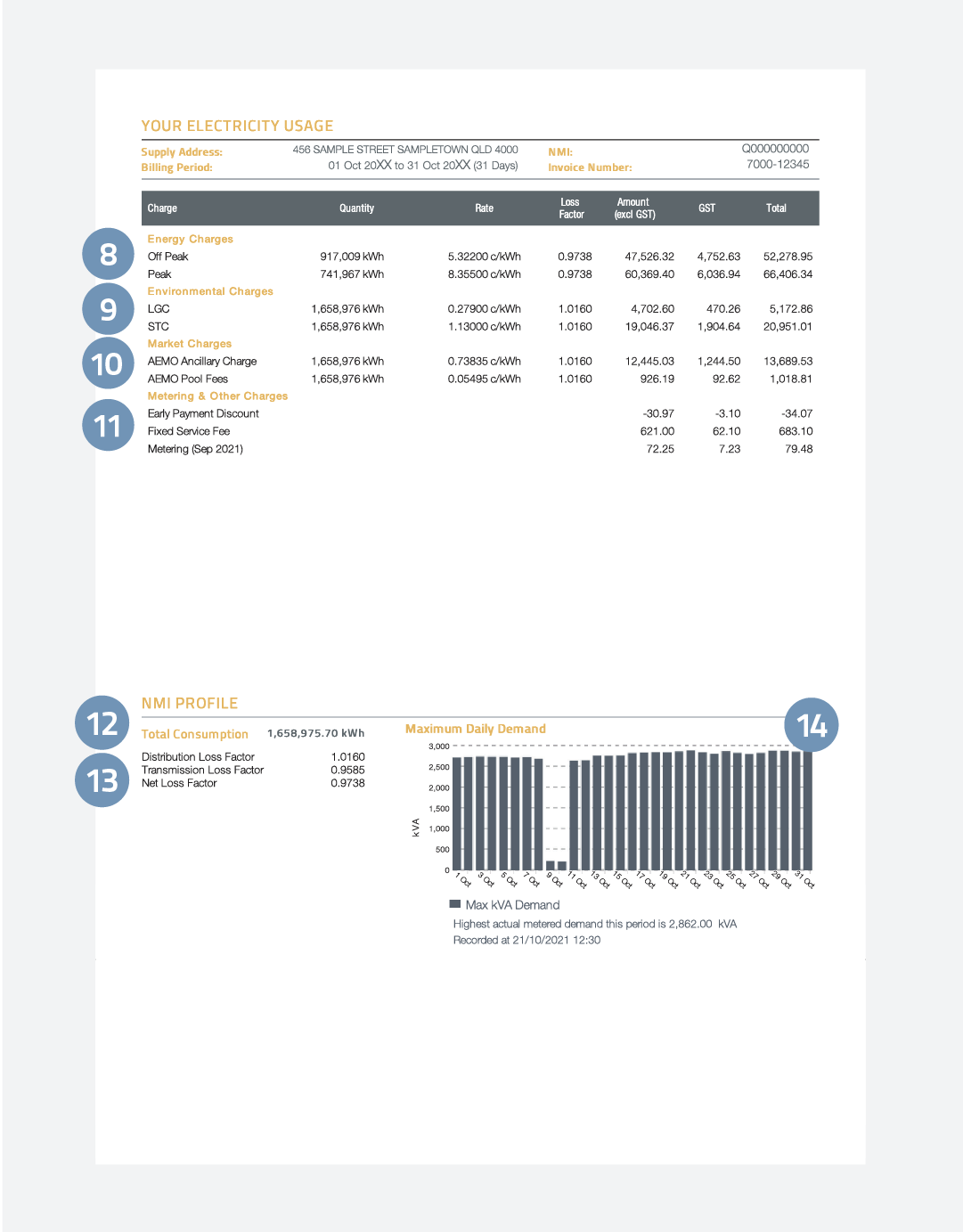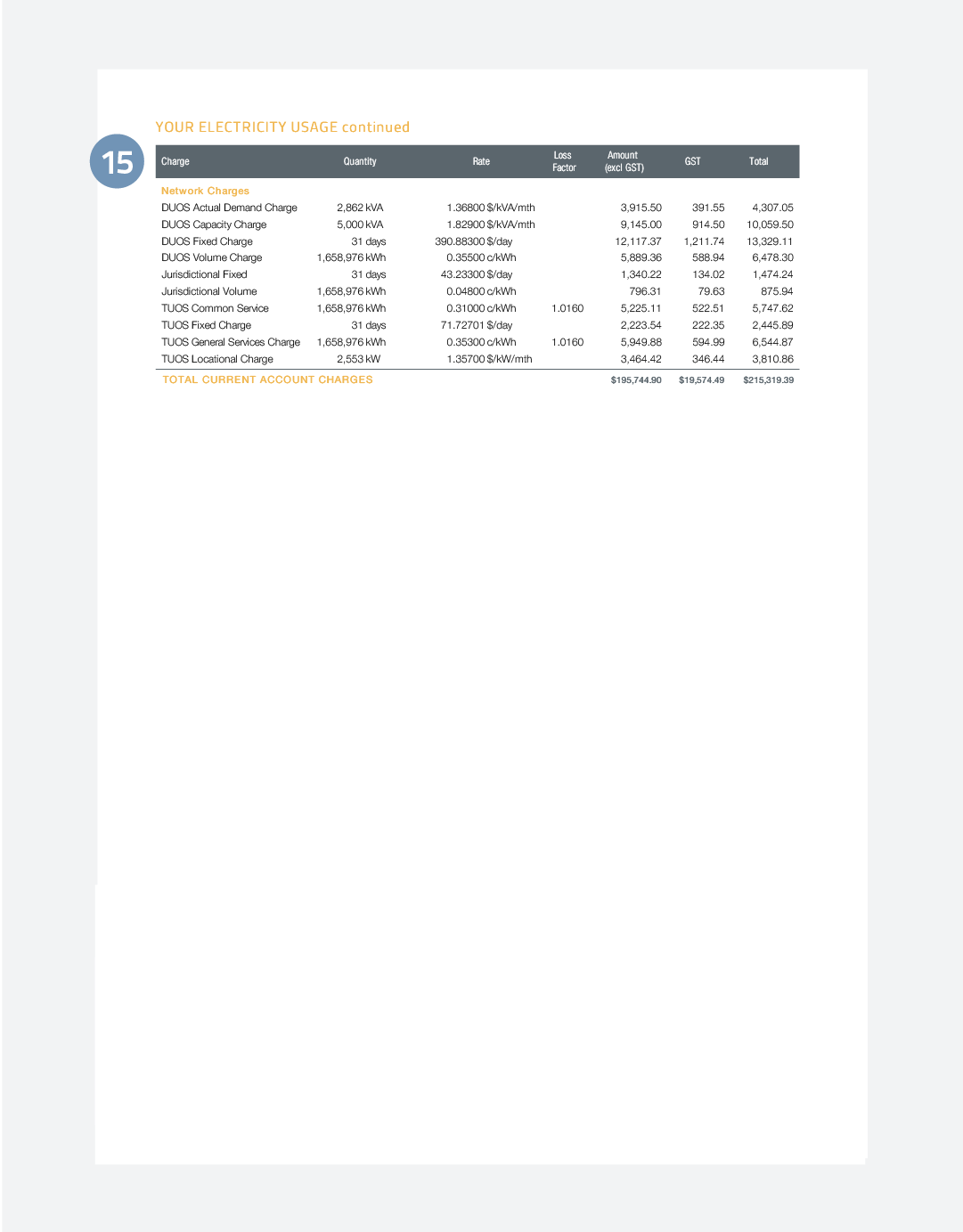At Stanwell Energy, we pride ourselves on delivering an outstanding level of ongoing support to industrial and commercial customers all along the eastern seaboard of Australia – and that includes making sure they understand their energy bill.
Our service is flexible, reliable and transparent – and so are our bills. Here, we’ve broken down a typical Stanwell Energy bill to show you exactly what you’re paying for.

1. Contact Details
Need to get in touch with us? You’ll find your Account Manager’s name and contact details here, as well as your supplier’s number to call in case of any urgent electricity supply issues.
2. Current Invoice Summary
A summary of the key details about this invoice at a glance.
This includes your National Metering Identifier (NMI), which is a unique number used to identify the electricity connection point at your premises. No two NMIs are the same, so this is a good number to quote if you have any questions about your electricity supply or your bill.
The summary also includes your invoice period, which is the date range and the number of days that it covers, and your supply address, which is the registered site address connected to the NMI.
It also includes a summary of the charges that make up the bill – see sections 8-12 below for more detail on those charges.
3. Your Bill Summary
Your bill will include a purchase order number (a unique number given to a specific transaction), if you’ve requested one. It will also contain your unique account number, and an invoice number.
The information on your bill is correct as of the invoice date. The due date is, of course, the date by which you need to pay the amount due – make sure you pay the correct amount by this date to avoid being charged interest.
4. Daily Electricity Usage Summary
This is a graphical representation of your electricity consumption in kilowatt hours (kWh), so you can easily see how much your business is using on a day-to-day basis. By comparing this summary with previous bills, you can see how this usage compares to the same period in previous years, and track the impact of new equipment you’ve installed and new business practices you’ve implemented.
5. Monthly Consumption
This is a graphical representation of how your energy usage has changed month-to-month, which can help you to see the impact of seasonal spikes on electricity usage. Again, by comparing it with previous bills, you can see how your average monthly consumption has changed from year to year.
This section also includes your Total Greenhouse Emissions for this billing period, and represents your average monthly emissions as a line on the graph.
6. Payment Methods
This section provides the details you need to pay via Electronic Funds Transfer or BPAY. You can also contact your bank or financial institution to arrange an alternative payment method.
7. Previous Amounts
This shows you if there is any outstanding balance carried over from the previous invoice, which will be added to the total amount due.

8. Energy Charges
How you’re charged for the consumption of electricity will depend on whether you’re on a flat rate or a time-of-use rate, and the different time-of-use periods specified in your contract.
If you’re on a flat rate, you’ll pay a fixed price for electricity, no matter what time of day you use it. But if you’re on a time-of-use rate, the price you pay for electricity will depend on when you use it.
This is the section of your bill that offers the most potential for cost savings, if you’re able to modify your business practices so that most of your energy use occurs in the ‘off-peak’ periods.
Your energy charges will be impacted by loss factors, which compensate for the energy lost as electricity flows through transmission and distribution networks. Approximately 10 per cent of the electricity that leaves Australian power stations is lost before it makes it to the end user. Loss factors are calculated by the Australian Energy Market Operator (AEMO) and adjusted annually.
9. Environmental Charges
Your energy bill also contains environmental charges related to State and Federal Government green schemes, which require retailers to acquire certificates to support renewable energy generation. For instance, these can include large-scale generation certificates (LGCs), small-scale technology certificates (STCs), NSW energy saving certificates (ESCs) and Victorian energy efficiency certificates (VEECs).
These charges are calculated using a standard regulated scheme percentage and a customer-agreed price, which can be found in your contract with us.
10. Market Charges
These are pass-through charges paid to AEMO. They reflect the cost of managing the National Electricity Market (NEM) and ensuring its safety, security and reliability.
11. Metering and Other Charges
These are pass-through charges for the provision of metering services to monitor your electricity usage. These services can be arranged directly by you under an agreement with a metering company.
12. NMI Profile
The total amount of electricity consumed at your National Metering Identifier (NMI) for the billing period. For more on your NMI, see Section 2 above.
13 Loss Factors
As described in Section 8, roughly 10 per cent of electricity is lost as it flows through transmission and distribution networks from the point of generation to the end user. Loss factors are determined in order to compensate for this. They are calculated by AEMO and adjusted every July; Stanwell has no control over these calculations.
14. Maximum Daily Demand
Your maximum daily demand charge reflects your maximum electricity usage over a 30-minute interval in the last 12 months. Your highest demand during this time is then used to calculate the demand value.

15. Network Charges
These are charges for use of the distribution network that delivers electricity to your site. Through these charges, you contribute towards the building, operation and maintenance of the poles and wires that make up the network.
The network provider determines your site’s tariff based on your electricity usage and consumption patterns. If you feel your tariff is too high, you can place a tariff change request once every 12 months via Stanwell.
To learn more about your bill, and for any other questions, contact your Account Manager today.



